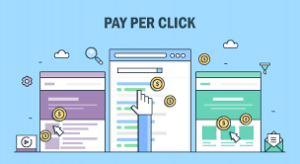
PPC Advertising is What your Business Needs
What is PPC?
PPC or pay-per-click is an online advertising model. The advertisers pay each time a user clicks on one of their online ads. In PPC advertising, businesses running ads are only charged when a user actually clicks on their ad. Hence the name “pay-per-click.”It’s essentially a method of ‘buying’ visits to your site.
So, what types of PPC are there?
- Search advertising
- Display advertising
- Social media advertising
- Re marketing
- Sequential re marketing
- Google Shopping
One of the most common types is the paid search ad. These ads appear when people search for things online using a search engine like Google. Especially when they are performing commercial searches.That means that they’re looking for something to buy in the digital world. This could be anything from a mobile search. Like someone looking for “pizza near me” on their phone to a local service search. For example: (someone looking for a dentist or a plumber in their area) to someone shopping for a gift (“Mother’s Day flowers”) or a high-end item like enterprise software. All of these searches trigger pay-per-click ads.
There are many PPC advertising platforms and ad types available Most advertisers who start with PPC advertising begin with a search campaign on Google Ads. This is often a good starting point for a lot of PPC advertisers. However, there are so many more options available to you. It is crucial to test new ad types and find the PPC advertising strategy that is right for your business.
How Does Pay-Per-Click Advertising Work?
In order for ads to appear alongside the results on a search engine, advertisers cannot simply pay more to ensure that their ads appear more prominently than their competitor’s ads. Instead, ads are subject to what is known as the Ad Auction. This an entirely automated process that Google and other major search engines use. Simply in order to determine the relevance and validity of advertisements that appear on their SERPs.
Beneficial Ways To Improve Your PPC Campaigns
- Expand Your Current Keyword List
There’s almost always room to expand your current keyword list. For example, you can add adjectives and adverbs to long-tail keywords, while short-tail keywords may perform better if such descriptive words are taken out.
- Identify Keywords With Poor Performance
Keywords can make or break your PPC advertising campaign. When reviewing your keywords, it’s important to check for those that aren’t performing well. Poor performance could be stemming from low bid value or search volume, but not always. It could also mean a high cost per lead.
Expand Your Negative Keyword List
To work on reducing costs and improving campaign performance, focus on regularly expanding and monitoring your negative keyword list. Also called “negative matches,” negative keywords are those that you don’t want to trigger your ad. One of the biggest advantages to having a negative keyword list is that it helps weed out “window shoppers” or leads that probably won’t end up converting.
Leverage Customer Reviews
Do you have great online reviews for your product, service or brand? Put them to good use in your PPC advertising campaigns.
You can use a seller ratings ad extension to display ratings as part of an ad for any products or advertising services. This is a great opportunity for you to establish trust and increase your click through rate as well.
Don’t miss these steps!
- Geo-target Your Ads
When managing your ad targeting, make sure you’re focused on the specific geographic locations where your products or services are relevant and available.
The best way to determine which regions you may want to target is by using the various geographic reporting features in your chosen paid search platform. If you use Google Ads, dig into your Locations and Distance reports to see performance data by location. From there, you can leverage the Location targeting setting to select specific areas where you want your ad to be shown, which can help reduce advertising campaign costs and improve ROI.
- Revisit Your Personas
If you haven’t made it a point to analyze your personas in a while, now is a good time to review current client and prospect demographics. (If you use a customer relationship management tool, this data is likely stored there.)
Ask yourself: Does this data match up with my understanding of my ideal client personas? If not, it may be time to adjust your advertising campaigns to reach undeserved segments of your target audience. Consumers’ preferences evolve, and you don’t want to risk missing out on potential leads by thinking they’re not part of your customer base.
- Refresh Your Landing Pages
When was the last time you took a hard look at your landing page data? An optimized, well-designed landing page can be the difference between a click turning into a lead or bouncing from your site.
Dig into how your landing pages are currently performing and how they stack up against one another. From there, see what A/B testing can be done, and look for ways to optimize your landing pages to increase completed actions, whether it’s a design refresh, new call-to-action copy or something else.


